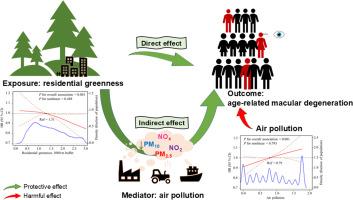住宅绿化、空气污染与年龄相关性黄斑变性:一项前瞻性队列研究
IF 6.3
2区 环境科学与生态学
Q1 ENVIRONMENTAL SCIENCES
引用次数: 0
摘要
现有证据表明住宅绿化对人类有益,但迄今为止还没有研究探讨绿化与年龄相关性黄斑变性(AMD)的关系。为了评估绿色度与AMD的关系以及空气污染的修饰和中介作用,我们进行了这项前瞻性研究。我们构建了加权分位数和(WQS)指数,以共同暴露于氮氧化物(NOx)、2.5µm颗粒物(PM2.5)、10µm颗粒物(PM10)。采用分层Cox回归模型检验暴露的影响。评价了大气污染整治的效果。中介分析采用间接法分层Cox模型和Aalen加性风险模型。在中位随访11.67年期间,确定了4596例AMD事件。每四分位数范围(IQR)增量的污染事件AMD的风险比(HRs)和95%置信区间(95% ci)分别为二氧化氮(NO2) 1.10(1.04-1.16)、氮氧化物(NOx) 1.09(1.03-1.15)、PM2.5 1.14(1.05-1.24)、PM10 1.13(1.05-1.21)。每IQR增加1000 m缓冲液的绿度与AMD相关的HR (95% CI)为0.91 (0.86 ~ 0.97),300 m缓冲液为0.94(0.89 ~ 0.99)。在WQS指数、NO2、NOx、PM2.5和PM10降低的介导下,1000 m绿化率与AMD的相关性分别为28.59%、44.77%、35.59%、32.31%和27.08%。增加绿化与降低AMD发病率相关,空气污染在一定程度上起到了中介作用,这意味着旨在改善空气质量和增加绿化的干预措施可能在减轻AMD风险方面具有双重益处。本文章由计算机程序翻译,如有差异,请以英文原文为准。

Residential greenness, air pollution, and incident age-related macular degeneration: A prospective cohort study
Existing evidence suggests residential greenness is beneficial to human, while no research to date explored the associations of greenness with age-related macular degeneration (AMD). To evaluate the association of greenness with AMD, modification and mediation effect of air pollution, we conducted this prospective study. We constructed weighted quantile sum (WQS) index as co-exposure to nitrogen oxides (NOx), particulate matter <2.5 µm (PM2.5), particulate matter <10 µm (PM10). Stratified Cox regression models were applied to test the effect of exposure. Effect modification of air pollution was assessed. Stratified Cox models through the indirect method and Aalen additive risk models were used in mediation analysis. Over median follow-up of 11.67 years, 4596 AMD events were ascertained. Hazard ratios (HRs) and 95 % confidence intervals (95 % CIs) of incident AMD for pollution per interquartile range (IQR) increment were 1.10 (1.04–1.16) for nitrogen dioxide (NO2), 1.09 (1.03–1.15) for NOx, 1.14 (1.05–1.24) for PM2.5, 1.13 (1.05–1.21) for PM10. The HR (95 % CI) of AMD associated with greenness 1000 m buffer per IQR increment was 0.91 (0.86–0.97), 300 m buffer was 0.94 (0.89–0.99). The association between greenness 1000 m and AMD was 28.59 %, 44.77 %, 35.59 %, 32.31 % and 27.08 % mediated by the decreased WQS index, NO2, NOx, PM2.5 and PM10, respectively. Increased greenness was associated with lower AMD incidence, and air pollution partly mediate it, which implies that interventions aimed at improving air quality and increasing greenness could have a dual benefit in mitigating AMD risk.
求助全文
通过发布文献求助,成功后即可免费获取论文全文。
去求助
来源期刊

Journal of Environmental Sciences-china
环境科学-环境科学
CiteScore
13.70
自引率
0.00%
发文量
6354
审稿时长
2.6 months
期刊介绍:
The Journal of Environmental Sciences is an international journal started in 1989. The journal is devoted to publish original, peer-reviewed research papers on main aspects of environmental sciences, such as environmental chemistry, environmental biology, ecology, geosciences and environmental physics. Appropriate subjects include basic and applied research on atmospheric, terrestrial and aquatic environments, pollution control and abatement technology, conservation of natural resources, environmental health and toxicology. Announcements of international environmental science meetings and other recent information are also included.
 求助内容:
求助内容: 应助结果提醒方式:
应助结果提醒方式:


